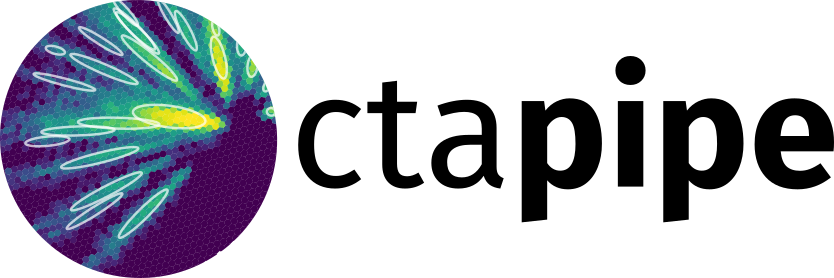"""
Class for calculation of likelihood of a pixel expectation, given the pixel amplitude,
the level of noise in the pixel and the photoelectron resolution.
This calculation is taken from :cite:p:`denaurois2009`.
The likelihood is essentially a poissonian convolved with a gaussian, at low signal
a full possonian approach must be adopted, which requires the sum of contributions
over a number of potential contributing photoelectrons (which is slow).
At high signal this simplifies to a gaussian approximation.
The full and gaussian approximations are implemented, in addition to a general purpose
implementation, which tries to intellegently switch
between the two. Speed tests are below:
neg_log_likelihood_approx(image, prediction, spe, ped)
29.8 µs per loop
neg_log_likelihood_numeric(image, prediction, spe, ped)
93.4 µs per loop
neg_log_likelihood(image, prediction, spe, ped)
59.9 µs per loop
TODO:
=====
- Need to implement more tests, particularly checking for error states
- Additional terms may be useful to add to the likelihood
"""
import numpy as np
from scipy.integrate import quad
from scipy.special import factorial
from scipy.stats import poisson
__all__ = [
"neg_log_likelihood_approx",
"neg_log_likelihood_numeric",
"neg_log_likelihood",
"mean_poisson_likelihood_gaussian",
"mean_poisson_likelihood_full",
"PixelLikelihoodError",
"chi_squared",
]
EPSILON = 5.0e-324
[docs]
class PixelLikelihoodError(RuntimeError):
pass
[docs]
def neg_log_likelihood_approx(image, prediction, spe_width, pedestal):
"""Calculate negative log likelihood for telescope.
Gaussian approximation from :cite:p:`denaurois2009`, p. 22 (equation between (24) and (25)).
Simplification:
.. math::
θ = σ_p^2 + μ · (1 + σ_γ^2)
→ P = \\frac{1}{\\sqrt{2 π θ}} · \\exp\\left(- \\frac{(s - μ)^2}{2 θ}\\right)
\\ln{P} = \\ln{\\frac{1}{\\sqrt{2 π θ}}} - \\frac{(s - μ)^2}{2 θ}
= \\ln{1} - \\ln{\\sqrt{2 π θ}} - \\frac{(s - μ)^2}{2 θ}
= - \\frac{\\ln{2 π θ}}{2} - \\frac{(s - μ)^2}{2 θ}
= - \\frac{\\ln{2 π} + \\ln{θ}}{2} - \\frac{(s - μ)^2}{2 θ}
- \\ln{P} = \\frac{\\ln{2 π} + \\ln{θ}}{2} + \\frac{(s - μ)^2}{2 θ}
We keep the constants in this because the actual value of the likelihood
can be used to calculate a goodness-of-fit value
Parameters
----------
image: ndarray
Pixel amplitudes from image (:math:`s`).
prediction: ndarray
Predicted pixel amplitudes from model (:math:`μ`).
spe_width: ndarray
Width of single p.e. peak (:math:`σ_γ`).
pedestal: ndarray
Width of pedestal (:math:`σ_p`).
Returns
-------
ndarray
"""
theta = 2 * (pedestal**2 + prediction * (1 + spe_width**2))
neg_log_l = np.log(np.pi * theta) / 2.0 + (image - prediction) ** 2 / theta
return neg_log_l
[docs]
def neg_log_likelihood_numeric(
image, prediction, spe_width, pedestal, confidence=0.999
):
"""
Calculate likelihood of prediction given the measured signal,
full numerical integration from :cite:p:`denaurois2009`.
Parameters
----------
image: ndarray
Pixel amplitudes from image (:math:`s`).
prediction: ndarray
Predicted pixel amplitudes from model (:math:`μ`).
spe_width: ndarray
Width of single p.e. peak (:math:`σ_γ`).
pedestal: ndarray
Width of pedestal (:math:`σ_p`).
confidence: float, 0 < x < 1
Upper end of Poisson confidence interval of maximum prediction.
Determines upper end of poisson integration.
Returns
-------
ndarray
"""
epsilon = np.finfo(np.float64).eps
prediction = prediction + epsilon
likelihood = np.full_like(prediction, epsilon, dtype=np.float64)
n_signal = np.arange(poisson(np.max(prediction)).ppf(confidence) + 1)
n_signal = n_signal[n_signal >= 0]
for n in n_signal:
theta = pedestal**2 + n * spe_width**2
_l = (
prediction**n
* np.exp(-prediction)
/ np.sqrt(2 * np.pi * theta)
/ factorial(n)
* np.exp(-((image - n) ** 2) / (2 * theta))
)
likelihood += _l
return -np.log(likelihood)
[docs]
def neg_log_likelihood(image, prediction, spe_width, pedestal, prediction_safety=20.0):
"""
Safe implementation of the poissonian likelihood implementation,
adaptively switches between the full solution and the gaussian
approx depending on the prediction. Prediction safety parameter
determines cross over point between the two solutions.
Parameters
----------
image: ndarray
Pixel amplitudes from image (:math:`s`).
prediction: ndarray
Predicted pixel amplitudes from model (:math:`μ`).
spe_width: ndarray
Width of single p.e. peak (:math:`σ_γ`).
pedestal: ndarray
Width of pedestal (:math:`σ_p`).
prediction_safety: float
Decision point to choose between poissonian likelihood
and gaussian approximation.
Returns
-------
ndarray
"""
approx_mask = prediction > prediction_safety
neg_log_l = np.zeros_like(image, dtype=np.float64)
if np.any(approx_mask):
neg_log_l[approx_mask] += neg_log_likelihood_approx(
image[approx_mask],
prediction[approx_mask],
spe_width[approx_mask],
pedestal[approx_mask],
)
if not np.all(approx_mask):
neg_log_l[~approx_mask] += neg_log_likelihood_numeric(
image[~approx_mask],
prediction[~approx_mask],
spe_width[~approx_mask],
pedestal[~approx_mask],
)
return neg_log_l
[docs]
def mean_poisson_likelihood_gaussian(prediction, spe_width, pedestal):
"""Calculation of the mean of twice the negative log likelihood for a give expectation
value of pixel intensity in the gaussian approximation.
This is useful in the calculation of the goodness of fit.
Parameters
----------
prediction: ndarray
Predicted pixel amplitudes from model
spe_width: ndarray
Width of single p.e. distribution
pedestal: ndarray
Width of pedestal
Returns
-------
ndarray
"""
theta = pedestal**2 + prediction * (1 + spe_width**2)
mean_log_likelihood = 1 + np.log(2 * np.pi) + np.log(theta + EPSILON)
return mean_log_likelihood
def _integral_poisson_likelihood_full(image, prediction, spe_width, ped):
"""
Wrapper function around likelihood calculation, used in numerical
integration.
"""
image = np.asarray(image)
prediction = np.asarray(prediction)
like = neg_log_likelihood(image, prediction, spe_width, ped)
return 2 * like * np.exp(-like)
[docs]
def mean_poisson_likelihood_full(prediction, spe_width, ped):
"""
Calculation of the mean of twice the negative log likelihood for a give expectation value
of pixel intensity using the full numerical integration.
This is useful in the calculation of the goodness of fit.
This numerical integration is very slow and really doesn't
make a large difference in the goodness of fit in most cases.
Parameters
----------
prediction: ndarray
Predicted pixel amplitudes from model
spe_width: ndarray
Width of single p.e. distribution
pedestal: ndarray
Width of pedestal
Returns
-------
ndarray
"""
if len(spe_width) == 1:
spe_width = np.full_like(prediction, spe_width, dtype=np.float64)
if len(ped) == 1:
ped = np.full_like(prediction, ped, dtype=np.float64)
mean_like = np.zeros_like(prediction, dtype=np.float64)
width = ped**2 + prediction * spe_width**2
width = np.sqrt(width)
for i, (pred, w, spe, p) in enumerate(zip(prediction, width, spe_width, ped)):
lower_integration_bound = pred - 10 * w
upper_integration_bound = pred + 10 * w
integral, *_ = quad(
_integral_poisson_likelihood_full,
lower_integration_bound,
upper_integration_bound,
args=(pred, spe, p),
epsrel=0.05,
)
mean_like[i] = integral
return mean_like
[docs]
def chi_squared(image, prediction, pedestal, error_factor=2.9):
"""
Simple chi-squared statistic from Le Bohec et al 2008
Parameters
----------
image: ndarray
Pixel amplitudes from image (:math:`s`).
prediction: ndarray
Predicted pixel amplitudes from model (:math:`μ`).
pedestal: ndarray
Width of pedestal (:math:`σ_p`).
error_factor: float
Ad-hoc error factor
Returns
-------
ndarray
"""
chi_square = (image - prediction) ** 2 / (pedestal + 0.5 * (image - prediction))
chi_square *= 1.0 / error_factor
return chi_square

